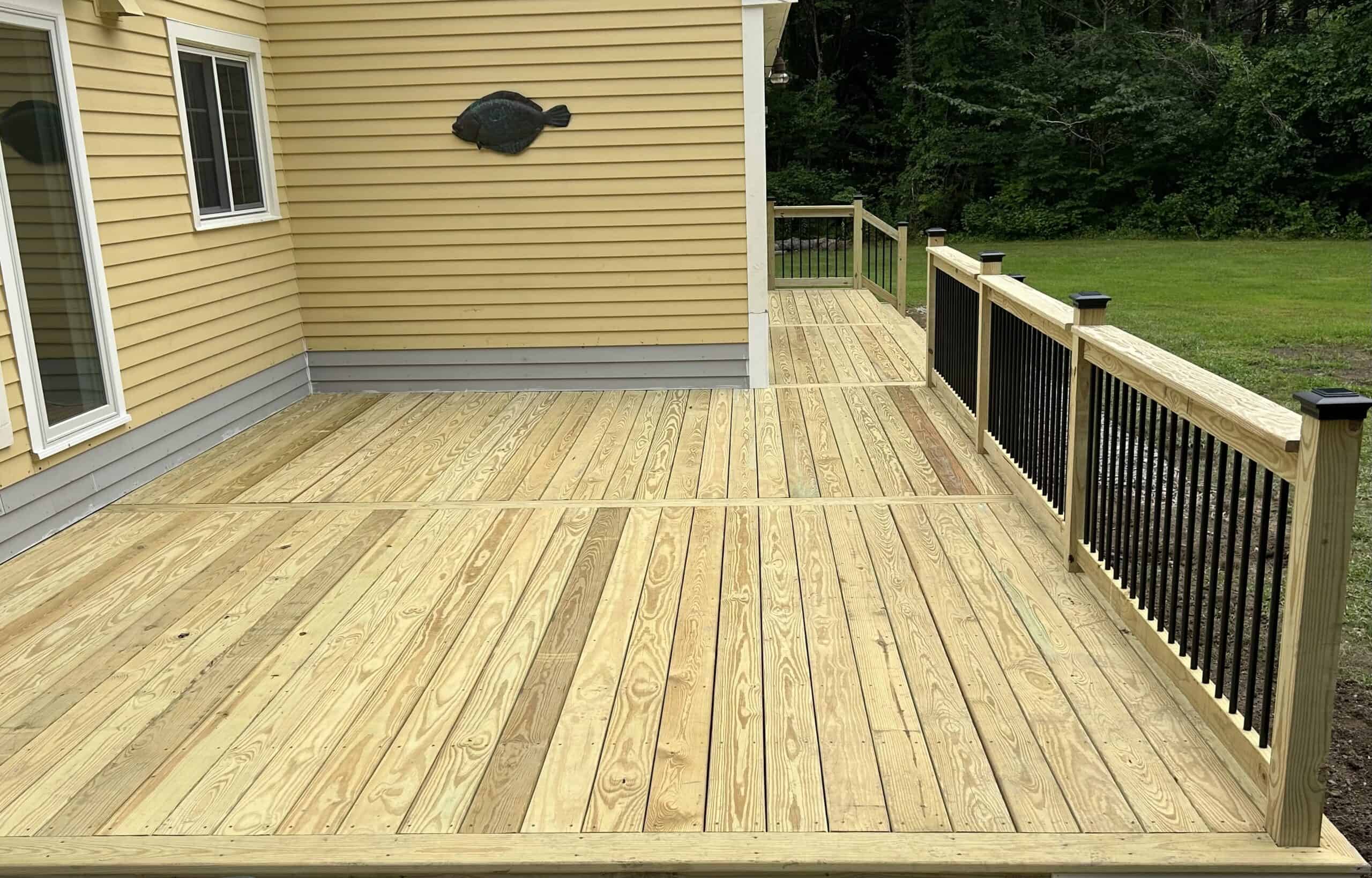
Maintaining & Cleaning Your Pressure Treated Deck
Maintenance: Keep Your Deck Looking Brand New
While there are many factors to consider when thinking about the longevity of your deck, let’s start with the most basic: Maintenance and Care. The simple act of cleaning your deck a few times a year will keep your deck looking brand new. You can also add sealants or stains every now and again to protect against the elements. In this article, we are going to walk you through how to maintain your deck over the years, as well as talk about some of the products we like using for our own decks!
Key notes
- Washing & Cleaning Your Deck
- Sealants & Stains
- How To Apply Sealant To Your Deck
- Frequently Asked Questions
Washing & Cleaning Your Deck
When you get a pressure treated deck, the wood overtime can start to look weathered or worn. It can grow mildew and even algae if there is standing water on the deck regularly or if it doesn’t get a lot of sunlight. Ever notice the wood gets a gray hue to it after a few years? You can prevent that to an extent with cleaning your deck!
Pressure washing your deck a few times a year can help keep it from looking like it is growing mildew and help keep the coloring of pressure treated boards for longer. You will want to use a deck cleaning solution and pressure wash on a low pressure setting. Remember: You don’t want to damage the wood with the high pressure water!
If you don’t have a pressure washer, or you want to be extra careful, you can get a scrub brush and some mild soap or deck cleaner. Use a garden hose to spray the deck off once you have finished scrubbing to ensure the deck is free of any debris and soap. This allows you to scrub away any mildew without the danger of damaging the wood’s surface.
Sealants & Stains
Another option for maintaining your deck is applying a sealant or stain every few years. When you first get your new pressure treated deck installed, the wood usually needs a few weeks to a few months to dry out. There are different factors that come into play with drying pressure treated wood. One being the time that has passed since the wood was treated, another is how much sunlight your deck gets. In general, the more sun hits your deck the faster it could dry out. Temperature and weather conditions are other factors.
You may be wondering how you can tell if your deck is dry enough: sprinkle some water onto the deck, if it takes about 10 minutes or less for the water to absorb, then the wood is dry and ready to be stained as soon as possible. If you notice the water did not absorb and is pooled on the top of the deck, it needs more time to dry.
If your deck is a bit older and the wood has already started to become discolored, you may want to wash your deck first. This was mentioned earlier, but washing the deck can help get any discoloration off the boards so the stain sticks better.
Deck sealants are generally a transparent coat that absorbs into the wood and applies a thin layer of protection against moisture while allowing the wood’s natural grain to show through. By applying a sealant to your deck, it adds another barrier to protect it against wood rot. However, sealants do not protect the wood from sunlight so overtime the wood will fade from the UV rays.
On the other hand, deck stains protect against water damage while also adding a pigment to the wood, protecting it against UV rays. Deck stains come in different opacities, from semi-transparent to solid. The more pigment in your deck stain, the more protected it is against the sun.
How To Apply Sealant To Your Deck: A Step By Step Guide
1
Check the weather and clear off your deck: You want to make sure there is at least 2 days with no rain with temperatures between 50 and 90 degrees to ensure the best seal.
2
Sanding: While sanding is not required, stains and sealants almost always look better on a smooth surface. Remember to read your products label and follow those instructions. If you notice any sharp edges or any areas that seem damaged, sanding may be the best option. This is especially important for handrails. You want a smooth surface for you and your guests to prevent any splinters!
3
Remove Debris: Sweeping or using a garden hose or leaf blower may be the best options to remove debris from your deck. Make sure there is no dirt or other debris to ensure the sealant has a clean base to absorb into.
4
Open and Stir the Sealant: Make sure you don’t shake the can! This can cause air bubbles to rise to the surface while it dries. Always stir the can with a paint stirrer and mix well.
5
Apply the Sealant: Use manufacturers directions. You can use a brush or a paint roller to apply a thin coat of the sealant over the entirety of the deck. You may want to do a few boards at a time. Make sure you get any heard to reach spots like between the boards, railings and steps.
6
Let it Dry: Make sure the deck is completely dry before you put your furniture or plants back and before use.
Frequently Asked Questions:
When is the best time to build a pressure treated deck?
Winter is generally a good time to think about building a pressure treated deck. In the winter, the humidity is low which allows the wood to dry faster than in the summer. When building a pressure treated deck in the summer, you want to think about warping and cracking. Building in the summer during peak humidity will cause the wood to absorb the humidity, which in turn, warps the wood. Winter also provides indirect sunlight for your deck. Winter is also the ‘off’ season for a lot of contractors, which means you can get your deck done faster without having to wait for contractor availability for months.
When is the best time to stain a deck?
You should always look at the label of the stain you chose. Oftentimes, it will tell you the best temperature for applying the stain. Make sure you check the label to see if you can apply the stain while the deck is still damp or if you should wait until the wood dries out. If you plan on staining your deck right away, make sure to purchase a stain designed for wet wood.
What products do you recommend for staining / sealing and washing my deck?
Benjamin Moore: Woodluxe Oil-Based waterproofing sealant and stain
Thompsons: WaterSeal
Wood Sealer
Thompsons: WaterSeal Advanced Natural Wood Protector
Benjamin Moore: Woodluxe All In One Wood Cleaner
Benjamin Moore: Woodluxe
Wood Restorer
